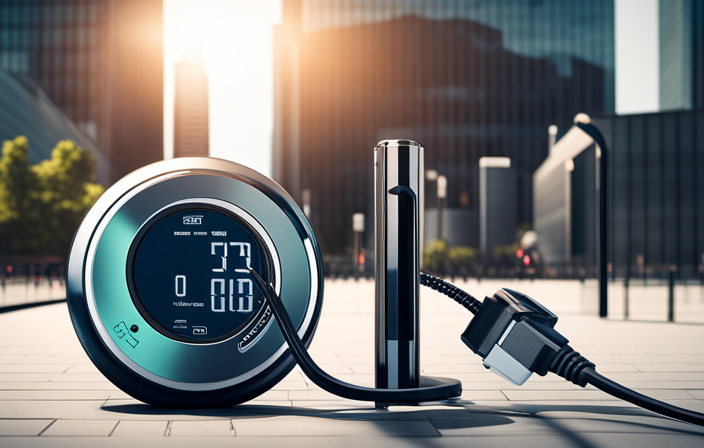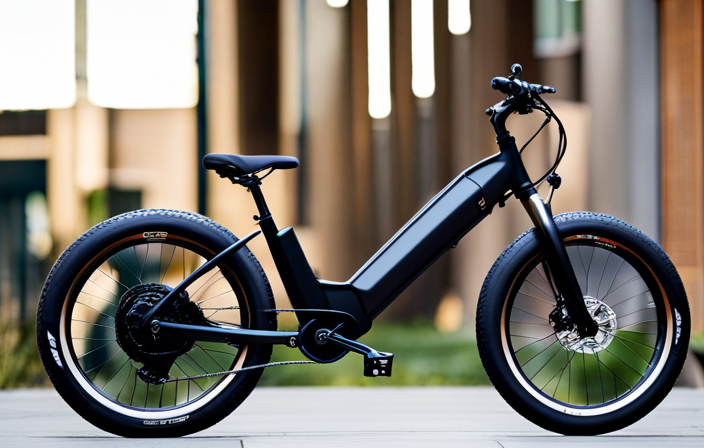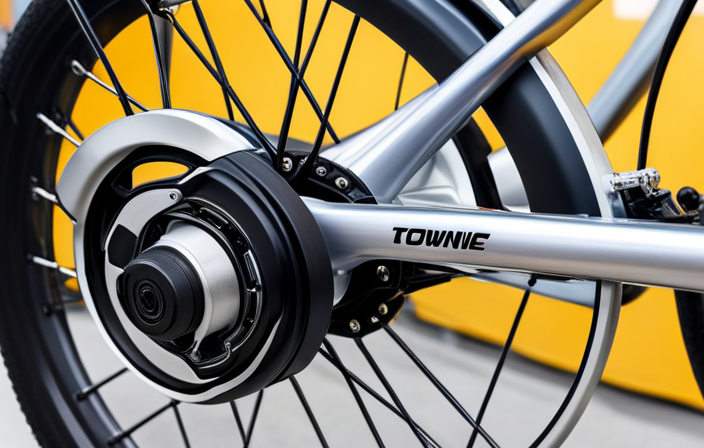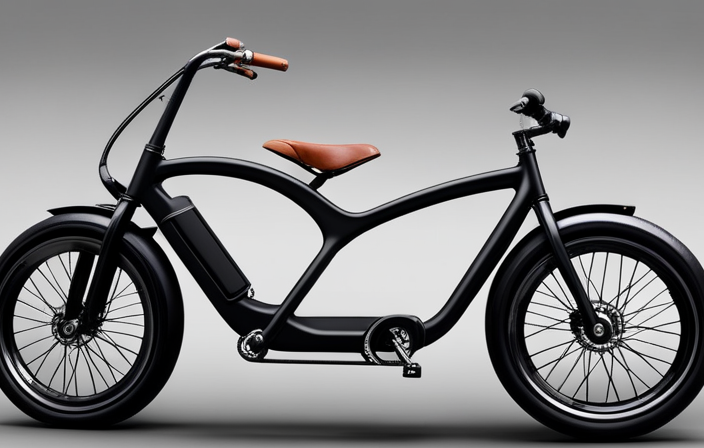Electric Bike
How Much Does It Cost To Charge An Electric Bike Battery

You may be wondering, ‘How much does it cost to charge an electric bike battery?’ Well, we’re here to break it down for you.
In this informative and detailed article, we will explore the factors that determine the cost of charging an electric bike battery, compare it to other modes of transportation, calculate the average cost, and provide tips for reducing the cost.
We will also delve into the environmental benefits of electric bikes and discuss the future of electric bike batteries.
So, let’s dive in and learn more about the affordability and long-term savings of owning an electric bike.
Key Takeaways
- Advancements in battery technology have made charging an electric bike battery more efficient and cost-effective.
- Government incentives and subsidies can help reduce the cost of charging an electric bike battery.
- Proper storage and regular charging can prolong the lifespan of an electric bike battery, leading to long-term savings.
- Charging an electric bike battery is significantly cheaper compared to fuel costs for traditional bikes or cars.
Factors that Determine the Cost of Charging an Electric Bike Battery
You’re probably wondering what factors determine the cost of charging your electric bike battery. Well, there are a few key factors that come into play.
The first is your average electricity consumption. The more you use your electric bike, the more you will need to charge its battery, and the higher your electricity bill will be. However, electric bikes are generally very energy-efficient, so the cost of charging them is relatively low compared to other modes of transportation.
Additionally, there are cost-saving strategies you can employ to minimize the impact on your wallet. For example, charging your electric bike during off-peak hours when electricity rates are lower can help reduce costs.
Now, let’s compare the cost of charging an electric bike to other modes of transportation to see just how affordable it really is.
Comparing the Cost of Charging an Electric Bike to Other Modes of Transportation
Comparing the expense of charging an e-bike to other modes of transportation is essential.
When it comes to cost comparison, electric bikes are a clear winner. The cost savings of charging an electric bike battery are significant when compared to the expenses of fueling a car or purchasing public transportation tickets.
On average, it costs around $0.50 to fully charge an electric bike battery, which can provide a range of 40 to 60 miles. In contrast, a gallon of gasoline can cost upwards of $3, and it may only take you around 20 miles. Public transportation fares can also add up, especially for daily commuters.
By choosing an electric bike, you can save a substantial amount of money on transportation costs.
Now let’s move on to calculating the average cost of charging an electric bike battery.
Calculating the Average Cost of Charging an Electric Bike Battery
When calculating the average cost of charging an electric bike battery, there are two key points to consider: the average electricity consumption of an electric bike and the cost per kilowatt-hour.
To determine the average electricity consumption, you need to know the wattage of the battery and how long it takes to fully charge. Once you have this information, you can multiply the wattage by the charging time to get the total watt-hours consumed.
Then, you can multiply this by the cost per kilowatt-hour to calculate the average cost of charging the battery.
Average Electricity Consumption of an Electric Bike
To estimate the electricity consumption of your electric bike, you’ll need to consider factors such as battery capacity, distance traveled, and the efficiency of your bike’s motor.
Here are some key points to keep in mind:
- Electric bike battery capacity: The higher the battery capacity, the more electricity it can store, allowing for longer rides before recharging.
- Distance traveled: The farther you ride, the more electricity your bike will consume.
- Efficiency of the motor: A more efficient motor will require less electricity to perform the same tasks.
Considering these factors will help you get a better understanding of your electric bike’s electricity consumption.
Now, let’s move on to the next section, where we’ll discuss the cost per kilowatt-hour and how it affects the overall charging expenses of your electric bike battery.
Cost per Kilowatt-Hour
The cost per kilowatt-hour affects the overall expenses of charging an electric bike’s battery. There are several factors affecting the cost per kilowatt-hour. These include the region you live in, the time of day you charge, and the electricity provider you use.
In some areas, the cost per kilowatt-hour may be higher during peak hours, while others may offer discounted rates during off-peak hours. It’s worth considering these factors when planning your charging schedule to save money.
Additionally, the benefits of charging an electric bike’s battery include lower maintenance costs, reduced carbon emissions, and the convenience of charging at home.
By being mindful of these factors and taking advantage of off-peak rates, you can reduce the cost of charging your electric bike’s battery.
Now, let’s explore some tips for further reducing these expenses.
Tips for Reducing the Cost of Charging an Electric Bike Battery
One way to reduce the cost of charging an electric bike battery is by using off-peak electricity rates. This means charging your bike during the times when electricity demand is lower, usually during the night. By doing so, you can take advantage of discounted rates offered by some utility companies, resulting in significant savings over time.
To further reduce charging costs, consider the following tips:
-
Invest in a fast charger: A faster charger can reduce charging time, allowing you to take advantage of lower electricity rates even more effectively.
-
Optimize battery performance: Properly maintaining your electric bike battery can improve its efficiency and reduce the amount of energy required for charging. Follow the manufacturer’s recommendations for charging cycles and storage to maximize its lifespan.
-
Use regenerative braking: Many electric bikes are equipped with regenerative braking systems that convert kinetic energy into electrical energy, which can then be used to charge the battery. Utilizing this feature can help offset charging costs.
Reducing the cost of charging your electric bike battery not only saves you money but also contributes to a more sustainable and environmentally friendly mode of transportation. Understanding the environmental benefits of electric bikes is essential in making informed decisions about their usage.
Understanding the Environmental Benefits of Electric Bikes
When it comes to the environmental benefits of electric bikes, you’ll be happy to know that they contribute to reduced carbon emissions. By choosing to ride an electric bike instead of driving a car, you’re helping to decrease air pollution and promote cleaner air for everyone.
Additionally, electric bikes are much quieter than traditional vehicles, which means less noise pollution in your neighborhood.
Reduced Carbon Emissions
Reduced carbon emissions can be achieved by using an electric bike. Its battery can be charged at a low cost.
Electric bikes contribute to reduced carbon emissions by consuming less fuel compared to traditional bikes or cars. By relying on electricity for power, electric bikes do not emit harmful greenhouse gases that contribute to climate change.
Additionally, the reduced fuel consumption of electric bikes not only benefits the environment but also saves you money on fuel expenses.
Moreover, electric bikes promote a healthier lifestyle as they encourage physical activity and reduce sedentary behavior. Regular exercise has numerous health benefits, including improved cardiovascular health and weight management.
By choosing an electric bike, you can reduce your carbon footprint and enjoy the health benefits it offers.
As we move on to discuss decreased air and noise pollution, let’s explore how electric bikes contribute to a cleaner and quieter environment.
Decreased Air and Noise Pollution
By using an electric bike, you can experience cleaner air and a quieter environment. Not only does this benefit you personally, but it also has a positive impact on your local community. Electric bikes produce zero emissions, reducing health risks associated with air pollution. Additionally, they operate silently, decreasing noise pollution and creating a more peaceful atmosphere.
To better understand the benefits of electric bikes, let’s take a look at the table below:
| Decreased Health Risks | Impact on Local Communities |
|---|---|
| Reduced air pollution | Quieter neighborhoods |
| Improved respiratory health | Enhanced quality of life |
| Lower risk of cardiovascular diseases | Better mental well-being |
| Decreased exposure to harmful toxins | Increased social interaction |
As you can see, electric bikes not only provide personal benefits but also contribute to a healthier and more enjoyable community. Considering these advantages, it’s worth exploring government incentives and rebates for electric bike owners. This will be discussed further in the next section.
Exploring Government Incentives and Rebates for Electric Bike Owners
Government incentives and rebates are available to help electric bike owners offset the cost of charging their bike batteries. Many governments worldwide recognize the environmental benefits of electric bikes and offer incentives to encourage their use. These incentives can include tax credits, grants, and subsidies that significantly reduce the cost of charging an electric bike battery.
In addition to these incentives, some governments provide rebates for the purchase of electric bikes and charging equipment. By taking advantage of these incentives, electric bike owners can save money and make their eco-friendly transportation option even more affordable.
As the popularity of electric bikes continues to grow, it is likely that government incentives and rebates will become even more common. This will further reduce the cost of charging electric bike batteries and make them an even more attractive option for environmentally conscious individuals.
Transitioning into the future of electric bike batteries, advancements in technology are expected to make them even more efficient and cost-effective.
The Future of Electric Bike Batteries
Get ready for the future of electric bike batteries. Advancements in technology are expected to make them even more efficient and cost-effective for you.
The future innovations in electric bike batteries are focused on extending their lifespan. This will greatly benefit owners in terms of longevity and value for money. Manufacturers are working on developing batteries that can last even longer, allowing riders to go on longer trips without worrying about running out of power.
These future batteries are also expected to have faster charging times, reducing the wait time for riders. With these improvements, electric bike owners can look forward to a future where their batteries last longer and charging becomes more convenient.
In the next section, we will explore the various charging options available for electric bike owners.
Charging Options for Electric Bike Owners
Looking for convenient ways to keep your electric bike powered up? Let’s explore the charging options available to you.
When it comes to charging your electric bike battery, there are a few options to consider. One of the fastest charging options is using a high-powered charger, which can significantly reduce charging time. These chargers are designed to deliver a higher voltage and current to your battery, allowing for a quicker charge.
Another option to consider is wireless charging technology. With this option, you simply place your electric bike on a charging pad, and it will wirelessly charge your battery. This eliminates the need for cords and makes charging even more convenient.
Now that you know about the faster charging options and wireless charging technology available, let’s move on to discussing the maintenance and care for electric bike batteries.
Maintenance and Care for Electric Bike Batteries
To ensure the longevity of your electric bike’s battery, it’s important to properly maintain and care for it. Electric bike battery lifespan can vary depending on several factors, such as the quality of the battery and how well it is maintained. By following some simple maintenance tips, you can maximize the lifespan of your battery.
First, make sure to store your battery in a cool, dry place when not in use. Extreme temperatures can negatively impact the battery’s performance. Additionally, avoid fully draining the battery before recharging it. Regularly charging it when it reaches around 20-30% capacity is recommended.
When it comes to battery disposal, it’s important to follow proper procedures to protect the environment. Many electric bike manufacturers and retailers offer recycling programs for old batteries. Contact them or your local recycling center for guidance on how to dispose of your battery responsibly.
Taking these steps will help you prolong the life of your electric bike battery and minimize its impact on the environment. In conclusion, by properly maintaining and caring for your electric bike battery, you can enjoy the long-term savings and affordability of electric bike ownership.
Conclusion: The Affordability and Long-Term Savings of Electric Bike Ownership
By properly maintaining and caring for your electric bike, you can enjoy the long-term savings and affordability of owning one.
Electric bikes offer several affordability benefits, such as lower fuel costs compared to traditional bikes or cars. The cost of charging an electric bike battery is relatively low, especially when compared to the cost of fuel for a gas-powered vehicle.
Additionally, there are government incentives available that can further reduce the cost of owning an electric bike, such as tax credits or rebates. As technology advances, the future of batteries for electric bikes looks promising, with improvements in capacity and charging time. This means that the cost of charging an electric bike battery will likely decrease even further in the future.
Overall, investing in an electric bike can provide significant long-term savings and contribute to a more sustainable future.
Frequently Asked Questions
Are there any safety precautions to take when charging an electric bike battery?
When charging an electric bike battery, there are several safety precautions to take. First, ensure you are using the correct charger and follow the manufacturer’s instructions. Avoid overcharging or charging in extreme temperatures.
Can I charge my electric bike battery using a regular power outlet?
Yes, you can charge your electric bike battery using a regular power outlet. However, there are alternative charging methods, like using solar panels or portable power stations, which can be more eco-friendly and convenient.
How long does it typically take to fully charge an electric bike battery?
It typically takes around 3-6 hours to fully charge an electric bike battery, depending on the charging speed and the capacity of the battery. Optimal charging time can vary, but it’s usually recommended to charge it overnight for maximum efficiency.
Are there any additional costs associated with owning an electric bike, apart from charging?
Apart from charging, you should consider electric bike maintenance and battery replacement costs. Regular maintenance may include tire replacements, brake adjustments, and chain lubrication. Battery replacement costs vary depending on the type and capacity of the battery.
Can I use a solar panel to charge my electric bike battery?
Yes, you can use a solar panel to charge your electric bike battery. The efficiency of solar panels has improved, making it a viable option. Using solar power for charging provides benefits like sustainability, cost savings, and independence from the electrical grid.
Conclusion
Congratulations on reaching the end of this informative journey!
Now that you have delved into the world of electric bike batteries, you have discovered their affordability and long-term savings.
By understanding the factors that determine the cost of charging, comparing it to other modes of transportation, and implementing tips to reduce costs, you are well-equipped to make informed decisions.
As you pedal into the future, remember the environmental benefits of electric bikes and the charging options available to you.
With proper maintenance and care, your electric bike battery will be your trusty companion on many adventures to come.
Happy riding!
Electric Bike
What The Best Electric Bike Shanghai

I’ve always loved riding through cities on a bicycle – feeling the wind in my hair and the freedom to go wherever I please.
So when I found myself in Shanghai, the electric bike capital of the world, I was thrilled.
The bustling streets, the vibrant culture, and the endless possibilities – all waiting to be discovered on the best electric bike Shanghai has to offer.
Join me as I dive into the world of city cruisers, mountain bikes, and everything in between, to find the perfect ride for your Shanghai adventure.
Key Takeaways
- Electric bikes in Shanghai are perfect for city tours and exploring historical landmarks quickly and efficiently.
- Mountain bikes are ideal for exploring Shanghai’s surrounding nature and offer a smooth and stable ride.
- Electric bikes allow you to discover pockets of serene greenery and beautifully maintained urban gardens in Shanghai.
- Folding bikes and electric scooters provide convenience and portability for commuters and travelers.
City Cruisers
The best electric bikes in Shanghai are perfect for cruising around the city. With their ease of use and electric assistance, they make city tours a breeze. One of the main advantages of these bikes is their ability to take you to historical landmarks with ease. Whether you want to explore the Bund, visit the Yu Garden, or admire the Oriental Pearl Tower, an electric bike can get you there quickly and efficiently.
These bikes are designed for comfort and convenience. They have adjustable seats, allowing you to find the perfect riding position for your city adventure. The electric motor provides a boost of power when needed, making it effortless to navigate through crowded streets or tackle inclines.
Not only are these bikes practical, but they also offer a fun and enjoyable way to explore the city. Riding through Shanghai’s bustling streets, you can take in the sights and sounds while effortlessly gliding from one landmark to another. The best electric bikes in Shanghai truly enhance the experience of discovering the city’s historical treasures.
As we transition to the next section about mountain bikes, it’s important to note that while electric bikes are ideal for city tours and historical landmarks, they may not be suitable for off-road adventures.
Mountain Bikes
When it comes to exploring Shanghai’s surrounding nature, off-roading adventures are a must.
Mountain bikes are the perfect choice for tackling rugged terrains and discovering hidden trails. With their advanced suspension systems and durable construction, mountain bikes offer a smooth and stable ride, allowing riders to confidently navigate through challenging landscapes.
Explore Shanghai’s Surrounding Nature
Discover the breathtaking natural beauty around Shanghai on an electric bike. As I rode through the city’s bustling streets, I was amazed to find pockets of serene greenery amidst the urban landscape.
Shanghai is home to numerous urban gardens, offering a peaceful escape from the city’s hustle and bustle. These gardens are beautifully maintained and provide a tranquil setting for a leisurely bike ride.
Additionally, there are plenty of hiking trails surrounding Shanghai that cater to all levels of fitness. From easy walks to challenging treks, these trails allow you to immerse yourself in nature and discover hidden gems just outside the city.
Exploring Shanghai’s surrounding nature on an electric bike is a truly remarkable experience that allows you to appreciate the city’s natural wonders. As I ventured off the beaten path, I couldn’t help but think about the exciting off-roading adventures that await.
Off-Roading Adventures
Get ready to experience the thrill of off-roading adventures just outside the city, where rugged trails and adrenaline-pumping terrain await. When it comes to off-roading, safety should always be a top priority. Before hitting the trails, make sure you have the right off-roading gear. A sturdy helmet, goggles, and gloves are essential for protecting yourself from potential hazards. Additionally, investing in a reliable 4×4 vehicle with proper off-road tires and a winch can greatly enhance your off-roading experience. To give you an idea of the gear you might need, here’s a table showcasing some essential off-roading equipment:
| Off-Roading Gear | Description |
|---|---|
| Helmet | Protects your head from impacts |
| Goggles | Shields your eyes from dirt and debris |
| Gloves | Provides grip and protects your hands |
| Off-Road Tires | Enhances traction on uneven surfaces |
| Winch | Helps recover your vehicle from tough spots |
Now that you have the right gear, let’s delve into the importance of suspension and durability in off-roading.
Suspension and Durability
To enhance your off-roading experience, make sure your vehicle’s suspension is properly tuned and built for durability. Suspension technology plays a crucial role in handling rough terrains and providing a smooth ride. Regular maintenance is key to ensuring the longevity and performance of your suspension system.
Start by inspecting your suspension components for any signs of wear or damage. Check the shocks and struts for leaks, and make sure the springs are in good condition. It’s also important to regularly clean and lubricate your suspension system to prevent dirt and debris buildup.
Additionally, consider investing in high-quality suspension upgrades that are specifically designed for off-road use. By taking these maintenance tips into account, you can ensure that your vehicle’s suspension is ready to tackle any off-road adventure.
When it comes to exploring new terrains, folding bikes are a convenient and versatile option.
Folding Bikes
When it comes to folding bikes, one of the key points that make them a popular choice is their compact and portable design.
These bikes are designed to be folded up easily, allowing them to be conveniently stored and carried.
This makes them ideal for commuters and travelers who need a bike that can be easily transported and stored in small spaces.
Compact and Portable Design
You’ll love the compact and portable design of the best electric bike in Shanghai.
This electric bike is perfect for city commuting with its travel-friendly features. Its compact size allows for easy maneuverability in crowded streets and tight spaces.
The portable design makes it convenient to take on public transportation or store in small spaces. With its lightweight frame and folding capabilities, you can easily carry it up stairs or fit it into the trunk of a car.
The bike also comes with a removable battery, making it even more convenient for charging and storing.
Whether you’re navigating through the city or traveling long distances, this electric bike’s compact and portable design will make your commuting experience hassle-free.
Easy to Store and Carry
The compact and portable design of this electric bike makes it easy to store and carry. With its lightweight design and clever storage solutions, this bike is perfect for those who are constantly on the go.
When not in use, the bike can be folded up and stored in small spaces, such as a closet or under a desk. Its lightweight frame allows for easy lifting and carrying, making it a convenient option for commuters and travelers. Whether you need to take it on a train or store it in the trunk of your car, this electric bike provides a hassle-free transportation solution.
Its compact size and lightweight design make it an ideal choice for those who value convenience and portability.
Ideal for Commuters and Travelers
If you’re constantly on the go, this electric bike is perfect for your commuting and traveling needs. With its commuter friendly features and optimized battery life, it’s designed to make your daily journeys a breeze.
Here’s why you’ll love it:
-
Lightweight and compact design: This electric bike is easy to maneuver and store, making it ideal for crowded city streets and small living spaces.
-
Long-lasting battery: The powerful battery provides ample power for your daily commutes, ensuring you never run out of juice in the middle of your journey.
With its convenient features and reliable performance, this electric bike is a top choice for commuters and travelers alike.
Now, let’s move on to the next topic and explore the world of fat tire bikes.
Fat Tire Bikes
I’ve always been fascinated by fat tire bikes and their ability to tackle any terrain with ease. These bikes provide exceptional stability and control, making them perfect for riders of all skill levels.
Whether you’re navigating through rocky trails or cruising on sandy beaches, a fat tire bike will provide the confidence and comfort you need for a thrilling and enjoyable ride.
Tackle Any Terrain with Ease
You can easily tackle any terrain with ease on the best electric bike in Shanghai. Whether you’re navigating rough trails or cruising through the city streets, this electric bike delivers exceptional off-road performance. With its powerful motor and sturdy construction, it effortlessly conquers steep hills and uneven surfaces. The battery life is also impressive, allowing you to ride for extended periods without worrying about running out of power.
The electric bike’s off-road performance is unmatched, thanks to its durable tires and robust suspension system. The long-lasting battery ensures that you can go the distance without any interruptions.
With its outstanding off-road capabilities and reliable battery life, this electric bike is truly a game-changer for adventurers and city commuters alike. And when it comes to stability and control, you can trust this bike to provide a smooth and enjoyable ride.
Stability and Control
When it comes to stability and control, trust in the bike’s reliable suspension system and responsive handling.
The advanced technology integrated into the bike ensures a smooth and comfortable ride, even on rough terrains. The suspension system absorbs shocks and bumps, providing stability and control throughout the journey.
With safety as a top priority, the bike is equipped with various safety features to enhance the rider’s confidence. These features include anti-lock brakes, traction control, and stability control, allowing the rider to maintain control in any situation.
Whether you are a beginner or an experienced rider, the bike’s stability and control make it suitable for all skill levels. Its intuitive handling and reliable suspension system ensure a safe and enjoyable ride, no matter your experience level.
Suitable for All Skill Levels
As I mentioned earlier, stability and control are crucial factors to consider when choosing an electric bike. However, it’s also important to find a bike that is suitable for your skill level.
Electric bikes are designed to cater to riders of all abilities, making them accessible to everyone. Whether you are a beginner or an experienced cyclist, there is an electric bike out there that will suit your needs.
When it comes to electric bike safety, it’s essential to choose a bike that has features such as reliable brakes, responsive handling, and good traction. Additionally, selecting the right electric bike involves considering factors like battery life, motor power, and weight. By taking all of these factors into account, you can ensure a safe and enjoyable riding experience.
Now let’s delve into the world of hybrid bikes, which offer the best of both worlds.
Hybrid Bikes
To find the best electric bike in Shanghai, consider checking out hybrid models. Hybrid bikes are a great option for those who want the best of both worlds – the convenience of an electric bike and the versatility of a traditional bicycle.
These bikes typically feature a lightweight frame, making them easy to handle and maneuver through busy city streets. They are equipped with a powerful electric motor that provides assistance when needed, allowing riders to easily tackle hills and long distances.
One of the key benefits of hybrid bikes is their ability to switch between pedal-assist mode and full electric mode, giving riders the flexibility to choose how much effort they want to exert. This makes hybrid bikes suitable for riders of all fitness levels and allows them to gradually increase their stamina over time.
Hybrid bikes also come with a range of features such as adjustable seat height, comfortable suspension, and reliable brakes, ensuring a smooth and safe riding experience. With their combination of electric and traditional bike features, hybrid bikes are a popular choice for commuters, recreational riders, and anyone looking for a versatile and efficient mode of transportation in Shanghai.
When it comes to cargo bikes, they offer a unique and practical solution for transporting goods and belongings around Shanghai. Instead of relying on backpacks or baskets, cargo bikes have specially designed frames and attachments that allow for the secure and easy transportation of cargo.
These bikes are equipped with sturdy racks, baskets, or even cargo boxes that can accommodate a variety of items, from groceries and packages to larger items like furniture or even pets. Cargo bikes are ideal for those who need to make frequent trips to the grocery store or need a reliable way to transport their belongings without the hassle of a car or public transportation.
They are also a popular choice for families, as they can easily accommodate children with the addition of a child seat or trailer. In addition to their practicality, cargo bikes also offer environmental benefits, as they provide a sustainable and emission-free alternative to traditional vehicles.
Whether you’re running errands or just need a reliable way to transport your belongings, cargo bikes are a versatile and efficient option in Shanghai.
Cargo Bikes
Cargo bikes are a practical and versatile solution for transporting goods and belongings in Shanghai. With their sturdy frames and spacious cargo areas, these bikes offer numerous benefits for individuals and businesses alike. Not only do they provide a sustainable mode of transportation, but they also help reduce traffic congestion and emissions in the city. Cargo bikes are particularly useful for local deliveries, as they can maneuver through narrow streets and park easily. Moreover, they offer a cost-effective alternative to car or motorcycle delivery services.
To enhance the functionality of cargo bikes, there are various accessories available in the market. These accessories can further optimize the cargo space and ensure the safe transportation of goods. Some popular cargo bike accessories include:
| Accessory | Description | Benefits |
|---|---|---|
| Cargo box | A secure and weatherproof enclosure for transporting goods | Protects items from damage and theft |
| Panniers | Side bags that attach to the frame | Increase carrying capacity and versatility |
| Electric assist | Battery-powered motor that provides additional power | Eases pedaling and enables effortless transportation |
Electric Scooters
After exploring the versatility of cargo bikes, let’s now turn our attention to electric scooters as another popular option for urban transportation.
Electric scooters are compact, lightweight, and offer a convenient way to navigate through busy city streets. Here are three key features that make electric scooters an attractive choice for many commuters:
-
Portability: Electric scooters are designed to be easily folded and carried, making them highly portable. This means you can effortlessly take your scooter on public transportation or store it in tight spaces.
-
Efficiency: With their electric motors, scooters offer a cost-effective and eco-friendly mode of transportation. They require less energy compared to cars and motorcycles, making them a sustainable option for short commutes.
-
Maneuverability: Electric scooters are nimble and agile, allowing riders to swiftly maneuver through traffic and congested areas. Their compact size enables them to fit into narrow gaps and find parking spots with ease.
With their compactness, efficiency, and maneuverability, electric scooters have become a popular choice for urban commuters seeking convenient and eco-friendly transportation options.
Now, let’s transition to our next subtopic: electric tricycles, which offer a unique twist on the traditional scooter design.
Electric Tricycles
Electric tricycles provide a great solution for individuals seeking stability and balance while riding. With three wheels, these tricycles offer enhanced stability, making them ideal for seniors and people with mobility issues.
Additionally, they are designed with comfortable seating and ample storage space, ensuring a comfortable and convenient ride for users.
Stability and Balance
To improve stability and balance on your electric bike in Shanghai, make sure to keep your body centered and your weight evenly distributed. This will help you stay in control and prevent accidents.
In addition to maintaining proper body position, there are several safety features that can enhance stability and balance on electric bikes:
- Anti-lock braking system (ABS): This feature prevents the wheels from locking up during sudden braking, ensuring better control and stability.
- Suspension system: A good suspension system absorbs shocks and vibrations, providing a smoother ride and improved balance.
- Wide tires: Electric bikes with wider tires offer better traction and stability, especially when navigating through uneven surfaces.
- Low center of gravity: Bikes with a lower center of gravity provide better stability and handling, reducing the risk of tipping over.
- Sturdy frame construction: A strong and durable frame adds stability, especially when riding at higher speeds or over rough terrains.
By incorporating these safety features, you can enjoy a safer and more stable ride on your electric bike in Shanghai.
Now let’s move on to the next section, where we will discuss the importance of comfortable seating and storage.
Comfortable Seating and Storage
After discussing the importance of stability and balance in electric bikes, let’s now explore another crucial aspect: comfortable seating and storage.
When it comes to seating, electric bikes often feature ergonomic designs that prioritize comfort and support. Padded seats with adjustable heights and angles ensure a personalized fit for riders of different sizes. Additionally, some models offer backrests and armrests for added comfort, especially on longer rides.
As for storage solutions, electric bikes are equipped with various options to meet riders’ needs. Many models come with built-in baskets or racks, allowing for easy transportation of groceries or personal items. Some even have storage compartments integrated into the frame, providing secure and convenient storage on the go.
With their comfortable seating and practical storage solutions, electric bikes are ideal for seniors and people with mobility issues, ensuring a smooth and enjoyable riding experience without the need for a step.
Ideal for Seniors and People with Mobility Issues
The comfortable seating and practical storage solutions of electric bikes make them an excellent choice for seniors and individuals with mobility issues. Electric bikes provide a comfortable and stable ride, with ergonomic seats that reduce strain on the back and joints.
For seniors who want to explore their city or go on city tours, electric bikes offer the perfect mode of transportation. With the added assistance of the electric motor, seniors can pedal with ease and enjoy the sights and sounds of their surroundings.
Electric bikes also come with accessibility options such as step-through frames, making it easier for individuals with limited mobility to mount and dismount the bike. These features make electric bikes a great choice for seniors and people with mobility issues who want to stay active and independent.
Speaking of bikes, another popular option is the retro-style bikes with their classic design and timeless appeal.
Retro-Style Bikes
I’ve heard that retro-style bikes are a popular choice in Shanghai for electric bike enthusiasts. These bikes are designed with a vintage-inspired look and incorporate features that harken back to a bygone era. The retro style design of these bikes often includes a mix of classic elements such as a step-through frame, leather saddle, and handlebar grips. Some models even feature a front basket, reminiscent of the bikes from the 1950s.
What sets these retro-style bikes apart is their ability to combine the charm of a vintage bike with the convenience of modern technology. While they may look like traditional bicycles, they are actually equipped with electric motors that provide an extra boost when needed. This makes them ideal for commuting through the bustling streets of Shanghai, where having that additional power can come in handy.
In addition to their stylish appearance and electric capabilities, retro-style bikes also offer other practical features. Many models come with built-in lights and fenders, ensuring visibility and protection from splashes while riding. Some even have integrated racks or panniers for carrying groceries or other essentials.
Transitioning into the subsequent section about road bikes, it’s clear that retro-style bikes cater to a specific aesthetic and practicality. However, for those seeking a different riding experience, road bikes offer a whole new set of advantages.
Road Bikes
Road bikes are known for their lightweight frames and aerodynamic design, making them a popular choice for cyclists who prioritize speed and efficiency. These bikes are specifically designed for riding on paved roads and offer a range of benefits for riders:
-
Road bike technology: Road bike technology has advanced significantly over the years, resulting in bikes that are lighter, faster, and more comfortable than ever before. Features such as carbon fiber frames, aerodynamic tube shapes, and lightweight components help to optimize performance and reduce fatigue during long rides.
-
Increased speed: The lightweight construction of road bikes allows riders to achieve higher speeds with less effort. The aerodynamic design reduces wind resistance, allowing cyclists to glide through the air more efficiently. This makes road bikes the ideal choice for those who enjoy racing or simply want to ride faster.
-
Improved fitness: Road biking is a great form of cardiovascular exercise that can help to improve fitness levels and burn calories. The constant pedaling and varied terrain provide a challenging workout that targets the leg muscles and helps to build strength and endurance.
Transitioning to the next subtopic about touring bikes, these bikes are specifically designed for long-distance travel and offer a range of features to enhance comfort and stability.
Touring Bikes
When it comes to exploring Shanghai and beyond, a touring bike is the perfect companion. These bikes are designed to be comfortable and durable, making them ideal for long-distance travel.
Whether you’re planning a weekend getaway or a cross-country adventure, a touring bike will provide the reliability and versatility you need to make the most of your journey.
Explore Shanghai and Beyond
Want to explore Shanghai and beyond on the best electric bike? Look no further! With our top-of-the-line electric bikes, you can effortlessly navigate the bustling streets of Shanghai and discover the hidden gems this vibrant city has to offer.
Immerse yourself in the local culture as you explore the diverse culinary scene, indulging in traditional dishes and street food delicacies. Cruise past iconic cultural landmarks like the Bund, Yu Garden, and the Oriental Pearl Tower, taking in the rich history and architectural marvels.
Our electric bikes are not only a convenient mode of transportation but also provide a comfortable and durable riding experience. So, get ready to embark on an unforgettable adventure and discover all that Shanghai and its surroundings have in store for you.
Comfortable and Durable
With our top-of-the-line electric bikes, you’ll have a comfortable and durable riding experience as you explore Shanghai and beyond.
Our bikes are carefully designed to provide maximum comfort, starting with the comfortable handlebars that allow for a relaxed grip and reduce strain on your hands and wrists.
Not only will you enjoy a smooth and comfortable ride, but you can also feel good about your choice in eco-friendly materials. Our bikes are made with sustainable and recyclable materials, minimizing their impact on the environment.
We believe that a comfortable and durable electric bike is essential for a truly enjoyable riding experience. So whether you’re exploring the bustling streets of Shanghai or venturing out into the countryside, our electric bikes are designed to handle it all.
And now, let’s talk about how our bikes are specifically designed for long-distance travel.
Designed for Long-Distance Travel
After discussing the comfortable and durable features of electric bikes, let’s delve into their design specifically tailored for long-distance travel.
Electric bikes are not only ideal for commuting or leisurely rides, but they are also perfect for long-distance touring. These bikes are equipped with powerful motors and high-capacity batteries, ensuring a smooth and effortless journey. With their ergonomic design and comfortable seating, riders can embark on extended trips without feeling fatigued.
Additionally, electric bikes offer eco-friendly travel options, as they produce zero emissions and reduce our carbon footprint. By choosing electric bikes for long-distance touring, we can explore new places while minimizing our impact on the environment.
Now, let’s shift our focus from electric bikes to another exciting mode of transportation: electric skateboards.
Electric Skateboards
When it comes to electric skateboards, you can expect a fun and exciting ride that will get your adrenaline pumping.
These boards are compact and portable, making them easy to bring along on your urban adventures.
Whether you’re cruising through the city streets or exploring new neighborhoods, electric skateboards are the perfect choice for urban exploration.
Fun and Exciting Ride
Get ready for a thrilling and exhilarating ride on the best electric bike in Shanghai! If you’re looking for a unique way to explore the city, our electric bikes are the perfect choice.
Designed for city tours and scenic routes, these bikes are equipped with powerful motors that provide a smooth and effortless ride. With adjustable speed settings, you can easily navigate through crowded streets or cruise along the waterfront with ease.
The electric bikes also come with a long-lasting battery, ensuring that you can cover long distances without any worries. And when it’s time to park or store your bike, you’ll appreciate its compact and portable design.
So get ready to hit the road and discover the beauty of Shanghai on the best electric bike in town!
Compact and Portable
Don’t forget to consider how easily you can transport and store the compact and portable electric bike. With its compact folding and lightweight design, this electric bike is a breeze to take with you on your adventures.
When folded, it takes up minimal space, making it convenient to store in small apartments or crowded public transportation. The lightweight construction allows for easy lifting and carrying, ensuring that you won’t strain yourself while maneuvering it. Whether you need to hop on a train or store it in the trunk of your car, this electric bike is designed for maximum portability.
Now, let’s move on to why this bike is also suitable for urban exploration.
Suitable for Urban Exploration
This electric bike is perfect for urban exploration due to its maneuverability and compact design. With its lightweight frame and agile handling, it allows me to effortlessly navigate through crowded city streets and narrow alleyways. The eco-friendly nature of this bike makes it a guilt-free choice for urban cycling, reducing my carbon footprint while enjoying the convenience of transportation.
Here are three reasons why this electric bike is ideal for urban exploration:
-
Easy parking: The compact design allows me to easily find parking spaces, avoiding the hassle of searching for larger spots or worrying about theft.
-
Quick acceleration: The electric motor provides instant acceleration, allowing me to swiftly navigate through traffic and reach my destination faster.
-
Versatile terrain: This bike can handle various terrains, from smooth city roads to slightly rougher paths, enabling me to explore different parts of the city without limitations.
Transitioning into the next section, electric unicycles offer another exciting option for urban commuters.
Electric Unicycles
Electric unicycles are a popular mode of transportation in Shanghai. They offer a unique and thrilling way to navigate the city streets. These electric-powered unicycles are compact, lightweight, and easy to maneuver, making them perfect for urban exploration. But they are not limited to just the concrete jungle.
Electric unicycles are also great for off-roading adventures. With their sturdy tires and powerful motors, electric unicycles can handle a variety of terrains. Whether it’s a dirt trail in the outskirts of the city or a rugged mountain path, these unicycles can conquer them all. The large battery capacity ensures long-lasting rides, allowing riders to venture further and explore new areas.
Off-roading on an electric unicycle provides an exhilarating experience. The thrill of gliding through rough terrains, feeling the wind in your face, and conquering challenging obstacles is hard to match. It’s a truly immersive way to connect with nature and push your limits.
Transitioning into the next section about sharing services, electric unicycles have become so popular that many sharing services now offer them as an option for commuters and adventurers alike. These services provide an affordable and convenient way to experience the thrill of electric unicycles without the need for ownership.
Sharing Services
Many sharing services now offer electric unicycles as an option for commuters and adventurers alike, providing a convenient way to experience the thrill without owning one. These services typically operate on a rental basis, allowing users to pick up and drop off electric unicycles at designated locations. Electric bike rental services also often include maintenance and repair services to ensure the safety and reliability of their fleet.
When renting an electric unicycle, it is important to follow safety guidelines and tips. Firstly, always wear a helmet and protective gear to minimize the risk of injury. Additionally, familiarize yourself with the controls and features of the electric unicycle before riding. Be cautious of your surroundings and follow traffic rules to ensure a safe ride. Lastly, never ride under the influence of alcohol or drugs.
Customization Options
When it comes to electric bikes, personalization is key.
With a wide range of customization options available, you can truly make your electric bike your own.
Add-ons and modifications such as baskets, racks, and lights can enhance both the functionality and style of your ride.
Personalize Your Electric Bike
To personalize your e-bike, you can easily customize the seat and handlebars to fit your comfort preferences. There are a variety of options available when it comes to personalizing your electric bike.
You can choose from a range of personalized accessories such as saddlebags, baskets, and cup holders to add functionality and style to your ride. Additionally, many e-bike manufacturers offer customizable frames, allowing you to choose the color, design, and even the material of your bike frame. This allows you to truly make your electric bike unique and reflective of your personal style.
By customizing the seat, handlebars, accessories, and frame of your e-bike, you can create a personalized and comfortable riding experience that is tailored to your preferences.
Moving forward, let’s explore the various add-ons and modifications that can enhance your e-bike even further.
Add-ons and Modifications
One way you can enhance your e-bike is by adding a powerful headlight for better visibility during nighttime rides. This safety feature not only helps you see the road ahead, but also makes you more visible to other drivers.
In addition to a headlight, here are some other add-ons and modifications to consider for your electric bike:
- Upgraded brakes for better stopping power
- Fenders to keep you dry and clean on rainy days
- Rearview mirrors for increased awareness of your surroundings
- A sturdy rack or basket for carrying groceries or other items
- A comfortable saddle for a more enjoyable ride
By investing in these add-ons and modifications, you can customize your electric bike to meet your specific needs and preferences, while also ensuring your safety on the road.
Now, let’s move on to creating the perfect ride for you.
Create the Perfect Ride for You
Looking to create the perfect ride for yourself? Let’s explore some customization options for your e-bike. When it comes to creating a personalized electric bike, it’s important to find the perfect fit for your needs. Whether you want to enhance the comfort, performance, or style of your ride, there are various modifications and add-ons available.
To help you visualize the possibilities, here’s a table showcasing some popular customization options:
| Customization Option | Description |
|---|---|
| Upgraded Seat | Provides extra cushioning and support for a more comfortable ride. |
| High-Performance Battery | Increases the range and power of your e-bike for longer and faster rides. |
| Custom Paint Job | Adds a unique and personalized touch to your bike’s appearance. |
| Rack and Panniers | Allows you to carry items easily, whether it’s groceries or work essentials. |
Frequently Asked Questions
Are electric bikes allowed on public transportation in Shanghai?
Yes, electric bikes are allowed on public transportation in Shanghai. This policy promotes electric bike safety and offers numerous benefits for commuters.
Electric bikes are an eco-friendly mode of transportation that helps reduce air pollution and traffic congestion in the city. They are also cost-effective and convenient, allowing riders to easily navigate through crowded streets and reach their destinations faster.
Overall, using electric bikes in Shanghai is a practical and sustainable choice for commuters.
Can electric bikes be rented through sharing services in Shanghai?
Yes, electric bikes can indeed be rented through sharing services in Shanghai. I remember the time when I decided to try out one of these services. It was so convenient! With just a few taps on my phone, I was able to locate and rent an electric bike in no time.
The benefits of using electric bikes in Shanghai are numerous – they are eco-friendly, cost-effective, and can easily navigate through the city’s busy streets.
What are the legal requirements for riding an electric bike in Shanghai?
To ride an electric bike in Shanghai, there are certain legal requirements to adhere to.
Firstly, electric bike registration is mandatory, and riders are required to carry the relevant registration documents while riding.
Additionally, there are speed limits in place for electric bikes, with a maximum speed of 20 kilometers per hour allowed on roads and 15 kilometers per hour on bicycle lanes.
It is important to comply with these regulations to ensure safe and legal riding in Shanghai.
Can electric bikes be used in bike lanes or must they ride on the road?
Electric bikes can be used in bike lanes or on the road, depending on the local regulations. In Shanghai, electric bikes are allowed to ride in designated bike lanes, which helps enhance electric bike safety. This is advantageous as it provides a separate space for electric bikes, reducing the risk of accidents with other vehicles.
Moreover, using bike lanes allows for smoother traffic flow and quicker travel times, making electric bikes a convenient mode of transportation in the city.
Are there any restrictions on where electric bikes can be parked in Shanghai?
In the bustling city of Shanghai, parking regulations for electric bikes can be likened to a game of musical chairs. Just like finding a spot for your favorite tune, finding a legal parking spot for your electric bike can be a challenge.
Shanghai has implemented regulations that restrict parking in certain areas, such as sidewalks and pedestrian zones. However, fear not! There are alternative transportation options available, such as designated parking lots and bike-sharing programs, to ensure convenient and hassle-free parking for your electric bike.
Conclusion
After exploring the various options for electric bikes in Shanghai, it is safe to say that there is a bike for every rider’s preference and need. Whether you are a city cruiser, mountain enthusiast, or someone who prefers the convenience of a folding bike, Shanghai has it all.
Not to mention the exciting options of electric skateboards and unicycles for those seeking a unique experience. With the added benefit of sharing services and customization options, the possibilities are endless.
So, why settle for anything less than the best when it comes to exploring Shanghai on wheels? Embrace the freedom and convenience that electric bikes offer and embark on your next adventure with style and ease.
Olivia’s writing is not only informative but also inspiring. She has a knack for telling stories that capture the essence of cycling and the joy it brings to people’s lives. Her writing has been praised by readers and industry experts alike for its clarity, depth, and authenticity.
In addition to her writing, Olivia is also an avid cyclist. She enjoys exploring new trails and routes and has participated in several cycling events and races. Her first-hand experience with cycling gives her a unique perspective on the sport, reflected in her writing.
Overall, Olivia is a talented writer passionate about cycling and dedicated to producing high-quality content for FlatironBike. Her contributions to the magazine have helped make it a go-to source for cycling enthusiasts worldwide.
Electric Bike
What Should I Look For In An Electric Bike?

Are you prepared to elevate your cycling skills? Get on an e-bike and enjoy the excitement of easy pedaling.
But before you dive into the world of e-bikes, there are a few things you should know. In this article, we’ll guide you through the process of finding the perfect electric bike for your needs. From motor power to frame design, we’ll help you make an informed decision that will have you cruising in style.
Key Takeaways
- Range, charging time, and battery capacity are important factors to consider when choosing an electric bike.
- Researching brand reputation and customer reviews can provide valuable insights into the performance and durability of the bike.
- Checking customer support and warranty coverage is crucial to ensure reliable assistance and protection against manufacturing defects.
- Evaluating bike comfort, handling, and power through test rides can help determine if the bike is suitable for your body and riding style.
Determine Your Riding Needs and Style
To find the right electric bike for you, think about how you’ll be using it and what style of riding you prefer. Electric bikes are designed for various purposes, such as commuting, off-road adventures, or leisurely rides around town. Consider whether you’ll be using the bike for daily commuting or occasional recreational rides.
If you plan to ride on rough terrains, look for a bike with sturdy construction and reliable suspension. On the other hand, if you’ll mainly be riding on paved roads, a more lightweight and streamlined option may be suitable.
Additionally, think about your preferred riding style. Do you enjoy a more upright position or a sportier, forward-leaning posture? Understanding your riding needs and style will help you narrow down the options before considering motor power and battery life.
Consider Motor Power and Battery Life
When considering an e-bike, it’s important to pay attention to the motor power and battery life. These two factors play a crucial role in determining the performance and range of your electric bike. Here are three key things to consider:
-
Motor Power: The motor power is measured in watts and determines how much assistance the electric bike can provide. Higher wattage motors generally offer more power and assist you in climbing hills or riding at higher speeds. Consider your riding needs and terrain when choosing the motor power.
-
Battery Life: The battery life indicates how far you can ride on a single charge. It is measured in watt-hours (Wh). A higher watt-hour rating means a longer range. Consider your daily commuting distance or the length of your rides to ensure the battery can support your needs.
-
Charging Time: Look for e-bikes with quick charging capabilities. Some batteries can be fully charged in just a few hours, while others may take longer. Consider your schedule and charging options when selecting an e-bike.
Considering these factors will help you make an informed decision when choosing an e-bike that meets your needs. Now, let’s move on to the next aspect: choosing the right frame design.
Choose the Right Frame Design
Consider which frame design best suits your riding style and preferences. The frame design of an electric bike plays a crucial role in determining its overall performance and comfort. There are various frame designs available, each with its own advantages and considerations. Here is a comparison of three common frame designs:
| Frame Design | Description | Pros |
|---|---|---|
| Step-Through | Features a low top tube, making it easy to mount and dismount. | Suitable for riders with limited mobility or those who frequently stop and start. |
| Mountain | Designed for off-road terrain, with a sturdy and durable build. | Ideal for adventurous riders who enjoy trail riding and rough terrains. |
| City/Commuter | Features a traditional diamond-shaped frame, providing stability and efficiency. | Great for urban commuting and everyday use. |
Choosing the right frame design will ensure a comfortable and enjoyable riding experience tailored to your needs. Now, let’s evaluate the quality of components to further enhance your electric bike selection process.
Evaluate the Quality of Components
Evaluating the quality of components is essential for ensuring optimal performance and durability. When choosing an electric bike, paying attention to the following aspects will help you make an informed decision:
-
Battery: Look for a high-quality lithium-ion battery that provides long-lasting power and has a reasonable charging time.
-
Motor: Consider the power and efficiency of the motor. A mid-drive motor offers better balance and control, while a hub motor provides a quieter ride.
-
Brakes: Opt for reliable disc brakes that offer excellent stopping power, ensuring your safety on the road.
-
Suspension: Check if the bike has front suspension forks or rear suspensions to absorb shocks and provide a smoother ride, especially on uneven terrains.
By evaluating these components, you can ensure that your electric bike will deliver the performance and durability you desire.
Now, let’s explore the next important aspect: looking for comfort features.
Look for Comfort Features
To ensure a comfortable ride, focus on finding features that prioritize your comfort and enjoyment. Look for an electric bike that offers adjustable seat height and handlebars, allowing you to find the perfect riding position. A padded saddle and ergonomic grips will help alleviate any discomfort during longer rides. Additionally, consider an electric bike with front suspension or a suspension seat post to absorb bumps and enhance overall ride quality. A step-through frame design can also provide easier mounting and dismounting, especially for those with limited mobility. Comfort features like these will make your electric bike riding experience more enjoyable and reduce strain on your body.
Now, let’s consider the weight and portability of the electric bike, as these factors are crucial when it comes to convenience and practicality.
Consider the Weight and Portability
When it comes to weight and portability, you’ll want to take into account how easy it is to carry and transport the electric bike. Here are three important factors to consider:
-
Weight: A lighter electric bike is easier to maneuver and carry, especially if you need to lift it onto a rack or take it up stairs. Look for lightweight materials like aluminum or carbon fiber to ensure easy handling.
-
Folding Mechanism: If you have limited storage space or frequently travel with your electric bike, consider one with a folding mechanism. This allows you to easily collapse the bike into a more compact size, making it convenient to store or transport in a car or public transportation.
-
Handlebar and Seat Adjustability: Ensure that the handlebar and seat height can be easily adjusted to fit your comfort level. This will make it easier to find the right riding position and accommodate different riders.
Considering the weight and portability of an electric bike is crucial for your overall convenience and ease of use. Now, let’s move on to checking the range and charging time.
Check the Range and Charging Time
Now, let’s see how far you can go on a single charge and how long it takes to recharge. When choosing an electric bike, it’s important to consider the range and charging time to ensure it meets your needs. The range refers to the distance you can travel on a fully charged battery, while the charging time indicates how long it takes to recharge the battery. To give you an idea, here’s a table showcasing the range and charging time of three popular electric bike models:
| Model | Range (miles) | Charging Time (hours) |
|---|---|---|
| A | 40 | 4 |
| B | 60 | 6 |
| C | 80 | 8 |
As you can see, the range and charging time vary depending on the model. Consider your typical riding patterns and how frequently you’ll need to recharge. This information will help you make an informed decision when choosing an electric bike that suits your lifestyle. Now, let’s move on to the next section and discuss the importance of researching the brand and customer reviews.
Research the Brand and Customer Reviews
Considering the brand and customer reviews is crucial when making a decision about which electric bike to purchase. Here are four key factors to consider:
-
Reputation: Research the brand’s history and reputation in the electric bike industry. Look for well-established companies that have been producing high-quality bikes for a considerable amount of time.
-
Customer reviews: Read customer reviews and ratings to get an idea of the bike’s performance, durability, and overall satisfaction. Pay attention to both positive and negative feedback to get a comprehensive understanding of the bike’s pros and cons.
-
Customer support: Check if the brand offers reliable customer support and after-sales service. A brand that values its customers and provides prompt assistance can make a significant difference if you encounter any issues or need assistance.
-
Warranty: Look for bikes that come with a solid warranty. A good warranty provides peace of mind and ensures that you are protected against any manufacturing defects or issues that may arise.
Considering these factors will help you make an informed decision when choosing an electric bike that fits your needs and preferences. Once you have assessed the brand and customer reviews, the next step is to set a budget and compare prices.
Set a Budget and Compare Prices
To make an informed decision about which electric bike to purchase, you’ll want to set a budget and compare prices. Electric bikes can vary greatly in cost, with some models starting as low as $500 and others exceeding $5,000. By setting a budget, you can narrow down your options and focus on bikes that are within your price range.
When comparing prices, be sure to consider the features and specifications that each bike offers. Keep in mind that higher-priced bikes often come with more advanced components and better build quality. However, it’s important to strike a balance between price and value for your specific needs.
Test Ride Before Making a Final Decision
Before you make a final decision, it’s important to test ride the electric bikes you’re considering. This will give you a firsthand experience of how the bike feels and performs, helping you make an informed choice.
Here are four reasons why test riding is crucial:
-
Comfort: By test riding, you can assess the bike’s comfort level, including the seating position, handlebar reach, and overall fit. This ensures you choose a bike that suits your body and riding style.
-
Handling: Test riding allows you to evaluate how the bike handles different terrains and road conditions. You can see how it responds to turns, accelerations, and decelerations, ensuring it meets your expectations.
-
Power: By test riding, you can experience the power and responsiveness of the electric motor. This helps you determine if the bike has sufficient power for your needs and preferences.
-
Range: Test riding gives you an idea of the bike’s range, or how far it can go on a single charge. This is crucial in ensuring the bike can cover your intended distances without running out of battery.
Conclusion
So there you have it, my friend! Now that you know what to look for in an electric bike, you’re ready to hit the road (or trail) with confidence.
Remember, finding the perfect e-bike is like finding the key to a magical kingdom of pedal-powered adventures. With the right riding needs, motor power, frame design, and quality components, you’ll be cruising in style.
Don’t forget to prioritize comfort features, range, and charging time. And of course, do your research, read customer reviews, and compare prices before making your final decision.
Happy riding!
Olivia’s writing is not only informative but also inspiring. She has a knack for telling stories that capture the essence of cycling and the joy it brings to people’s lives. Her writing has been praised by readers and industry experts alike for its clarity, depth, and authenticity.
In addition to her writing, Olivia is also an avid cyclist. She enjoys exploring new trails and routes and has participated in several cycling events and races. Her first-hand experience with cycling gives her a unique perspective on the sport, reflected in her writing.
Overall, Olivia is a talented writer passionate about cycling and dedicated to producing high-quality content for FlatironBike. Her contributions to the magazine have helped make it a go-to source for cycling enthusiasts worldwide.
Electric Bike
What Speed Can An Electric Bike Do

You may have doubts about the speed capabilities of electric bikes, but I can guarantee you that these vehicles are capable of reaching higher speeds than you may realize.
As an avid cyclist and electric bike enthusiast, I have explored the capabilities of various electric bikes firsthand.
In this article, I will delve into the factors that determine the speed of an electric bike, including motor power, battery capacity, rider’s weight, and terrain.
By the end, you’ll have a thorough understanding of just how fast an electric bike can go.
Key Takeaways
- Electric bikes can reach speeds of up to 20 mph on flat roads.
- Rider’s weight can affect the speed of the bike, with heavier riders experiencing slower speeds.
- Fitness level influences pedaling force and speed.
- Factors like wind and weather conditions can impact the performance of electric bikes.
Types of Electric Bikes
There are various types of electric bikes available, each offering different features and capabilities.
When it comes to electric bike motors, there are typically two types to choose from: hub motors and mid-drive motors.
Hub motors are located in the center of the wheels and provide a smooth and quiet ride.
On the other hand, mid-drive motors are positioned near the pedals, which allows for better weight distribution and improved handling.
As for battery technology, lithium-ion batteries are the most common choice due to their high energy density and long lifespan.
These batteries offer sufficient power and can be easily recharged.
Transitioning into the next section, the motor power and performance of an electric bike play a crucial role in determining its speed and capabilities.
Motor Power and Performance
When it comes to electric bike motors, two important factors to consider are wattage and torque. The wattage of a motor determines its power output, with higher wattage motors providing more power.
On the other hand, torque refers to the rotational force that the motor can produce, and is crucial for uphill climbs and acceleration.
Another important consideration is the choice between hub motors and mid-drive motors. Hub motors are typically located in the front or rear wheel, while mid-drive motors are integrated into the bike’s crankshaft.
Each type has its own advantages and disadvantages, with hub motors offering simplicity and ease of maintenance, while mid-drive motors provide better weight distribution and a more natural riding experience.
Lastly, motor efficiency plays a crucial role in the overall performance and battery life of an electric bike. A more efficient motor will convert more of the battery’s power into forward motion, resulting in longer battery life and better overall performance.
Wattage and torque
To determine the speed an electric bike can achieve, you’ll want to consider the wattage and torque of the motor. The motor design plays a crucial role in determining the power output of the electric bike. Here are some key factors to consider:
- Wattage: The higher the wattage of the motor, the more power it can deliver to propel the bike forward.
- Torque: Torque is the twisting force that the motor generates. Higher torque allows for better acceleration and climbing capabilities.
- Motor Efficiency: A more efficient motor will convert a higher percentage of electrical power into mechanical power, resulting in better overall performance.
- Power Output: The combination of wattage and torque determines the power output of the motor, which directly affects the bike’s top speed.
Now, let’s delve into the different types of electric bike motors: hub motors vs. mid-drive motors.
Hub motors vs. mid-drive motors
If you’re considering an electric bike, hub motors and mid-drive motors are two different types to explore. When it comes to motor performance, understanding the differences between these two technologies is crucial.
Hub motors are located in the center of the wheel and provide direct power to the bike’s wheels. They offer good acceleration and are generally easier to maintain. On the other hand, mid-drive motors are positioned near the bottom bracket, which allows for better weight distribution and a more natural feel when pedaling. They offer higher torque and are better suited for off-road and hilly terrains.
Both motor technologies have their advantages and disadvantages, so it’s important to consider your specific needs and preferences.
Now, let’s delve into motor efficiency and battery life.
Motor efficiency and battery life
Understanding the differences in motor efficiency and battery life is crucial when considering the performance of hub motors and mid-drive motors. Hub motors are known for their simplicity and ease of maintenance, while mid-drive motors offer better efficiency and a more natural riding experience. When it comes to motor maintenance, both types require regular cleaning and lubrication to ensure optimal performance. Additionally, battery charging is an important aspect to consider. Hub motors typically have built-in batteries, making them easier to charge, while mid-drive motors often rely on removable batteries that can be charged separately. By understanding the maintenance requirements and battery charging methods of each motor type, you can make an informed decision when choosing the right electric bike for your needs.
| Motor Type | Maintenance | Battery Charging |
|---|---|---|
| Hub Motor | Simple | Built-in |
| Mid-Drive | Regular | Removable |
Moving on to battery capacity and range…
Battery Capacity and Range
When it comes to the range of an electric bike, there are several factors that can affect its performance. These factors include the terrain, the weight of the rider, the level of assistance provided by the motor, and the overall efficiency of the battery.
On average, electric bikes have a range of around 20 to 50 miles, but this can vary depending on the specific model and battery capacity.
To maximize the battery life, it is important to maintain a consistent speed, avoid excessive acceleration and braking, and keep the tire pressure at the recommended level.
Factors affecting battery range
One of the factors that can affect the battery range of an electric bike is the terrain you are riding on. Different terrains require varying amounts of power to traverse, which can significantly impact the distance you can travel on a single charge.
Additionally, battery charging methods also play a role in determining the range of an electric bike. Fast charging, for example, may provide a quick boost but can also lead to reduced overall battery lifespan.
Moreover, the temperature can have a significant impact on battery performance. Extreme cold or heat can cause the battery to lose capacity and reduce its overall range. It is important to consider these factors when planning your electric bike rides to ensure you have enough power to reach your destination.
With a thorough understanding of these factors, you can maximize the battery range of your electric bike.
Transition: Now that we have explored the various factors that can affect the battery range of an electric bike, let’s move on to discussing the average range of electric bikes.
Average range of electric bikes
Now that we understand the factors that can affect the range of an electric bike, let’s take a closer look at the average range of these bikes. The bike range refers to the distance an electric bike can travel on a single charge of its battery. The actual range can vary depending on various factors such as the bike’s battery capacity, motor power, terrain, rider weight, and riding style.
To give you a better understanding, let’s take a look at the table below, which provides a comparison of the average range of electric bikes based on their battery capacity:
| Battery Capacity (Wh) | Average Range (Miles) |
|---|---|
| 300 | 20-30 |
| 400 | 30-40 |
| 500 | 40-60 |
| 600 | 50-70 |
| 700 | 60-80 |
As you can see, the bike range increases with a higher battery capacity. However, it’s important to note that these ranges are estimates and can vary depending on other factors as mentioned earlier.
Now that we have a better understanding of the average range of electric bikes, let’s move on to the next section where we will discuss some tips for maximizing battery life.
Tips for maximizing battery life
To get the most out of your battery life, it’s important to follow these tips:
-
Charge your battery properly: Avoid overcharging or leaving the battery on the charger for extended periods, as it can diminish its capacity over time.
-
Use the appropriate assist level: Adjusting the assist level to match your riding conditions can help conserve battery power and extend its life.
-
Maintain proper tire pressure: Keeping your tires inflated to the recommended pressure can reduce rolling resistance and improve overall efficiency.
-
Avoid extreme temperatures: Extreme heat or cold can negatively impact battery performance, so try to store and use your electric bike in moderate temperatures.
By implementing these practices, you can significantly extend your battery life and preserve its capacity.
Now, let’s discuss how the rider’s weight and fitness level can affect electric bike performance.
Rider’s Weight and Fitness Level
If you’re wondering how fast an electric bike can go, it all depends on your weight and fitness level. Maximizing performance on an electric bike involves understanding the impact of weight distribution.
When riding, the weight of the rider is a crucial factor in determining the bike’s speed. A heavier rider may experience slightly slower speeds compared to a lighter rider due to the increased load on the bike’s motor. Similarly, the rider’s fitness level affects the bike’s speed. A fit rider can pedal with greater force, which translates to higher speeds.
To maximize your electric bike’s performance, it is important to maintain a healthy weight and stay physically active. Additionally, regular maintenance of the bike’s components will ensure optimum performance.
Now, let’s delve into the impact of terrain and riding conditions on electric bike speed.
Terrain and Riding Conditions
When it comes to electric bikes, understanding how they perform on different terrains and riding conditions is crucial.
On flat roads and bike paths, electric bikes can reach impressive speeds, thanks to their powerful motors and efficient design.
However, climbing hills and steep inclines can be more challenging, as the motor’s power may be limited and the rider’s weight and fitness level come into play.
Additionally, factors like wind and weather conditions can also impact the overall performance and efficiency of electric bikes, affecting both speed and range.
Speed on flat roads and bike paths
You can easily reach speeds of up to 20 miles per hour on flat roads and bike paths with an electric bike. To accurately measure your speed, it’s important to have a reliable bike speedometer. However, be aware that not all speedometers are 100% accurate, as factors like tire size, air pressure, and wheel circumference can affect their readings.
Additionally, tire pressure plays a significant role in your bike’s speed. Higher tire pressure reduces rolling resistance, allowing you to achieve faster speeds. On the other hand, lower tire pressure can decrease your speed due to increased friction with the road. So, it’s essential to maintain proper tire pressure for optimal performance.
Now, let’s transition into discussing the performance of electric bikes when climbing hills and steep inclines.
Climbing hills and steep inclines
Climbing hills and steep inclines can be challenging, especially with an electric bike. However, with the right bike gearing and battery charging, conquering these obstacles becomes easier. Here are three key factors to consider:
-
Proper gear ratios: Electric bikes often come with multiple gears, allowing riders to adjust their gear ratio to match the steepness of the hill. This ensures efficient power transfer and helps maintain a comfortable pedaling cadence.
-
Battery capacity: Steep inclines require more power, which can drain the battery faster. It’s essential to have a fully charged battery before tackling hilly terrain to ensure optimal performance throughout the climb.
-
Battery management: To maximize battery life and range, it’s important to monitor the battery’s charge level and adjust the level of assistance accordingly. By utilizing the appropriate power modes, riders can extend their battery life and tackle hills with confidence.
Considering these factors, electric bike riders can confidently take on hills and steep inclines. However, it’s important to also consider the impact of wind and weather conditions.
Impact of wind and weather conditions
Taking wind and weather conditions into account will greatly affect your ability to conquer hills and steep inclines on an electric bike. Wind resistance plays a significant role in determining the speed at which you can climb. When facing a headwind, you will experience increased resistance, making it more challenging to maintain your desired speed. On the other hand, a tailwind can provide a helpful push, enabling you to conquer hills with greater ease.
Additionally, rain can also impact your electric bike’s speed. Wet roads can reduce traction, making it harder to maintain control and slowing you down. It is essential to adjust your riding technique and be cautious when riding in wet conditions. Understanding the impact of wind resistance and the effect of rain on electric bike speed is crucial for successfully tackling hills and inclines.
Considering these factors, it’s important to also be aware of legal speed limits.
Legal Speed Limits
The legal speed limit for electric bikes varies depending on the location. It’s important to know the bike speed restrictions in your area to avoid any legal issues. Here are some key points to consider:
-
Different Types: Speed limits for electric bikes can vary based on the type of bike. For example, pedal-assist bikes usually have higher speed limits compared to throttle-only bikes.
-
Local Regulations: Each region or country may have its own specific speed limits for electric bikes. It’s crucial to familiarize yourself with the local laws to ensure compliance.
-
Maximum Speed: Electric bikes generally have a maximum speed limit set by the manufacturer. It’s important to know and adhere to this limit for your safety.
-
Modifications: Modifying an electric bike can affect its speed and may even result in exceeding the legal limits. It’s essential to understand the potential consequences of any modifications before making them.
Understanding the legal speed limits for electric bikes is a crucial step in responsible riding. Now let’s explore the impact of bike components and modifications.
Bike Components and Modifications
Now that we understand the legal speed limits for electric bikes, let’s delve into the world of bike components and modifications.
When it comes to maximizing speed, one crucial factor is the bike frame material. Lightweight materials such as carbon fiber and aluminum are commonly used to reduce overall weight and increase maneuverability. These materials offer a perfect balance between strength and weight, allowing riders to achieve higher speeds without compromising durability.
Additionally, aerodynamics play a significant role in reducing wind resistance and enhancing speed. Bike manufacturers often incorporate design elements like streamlined frames, narrow handlebars, and integrated components to minimize drag and optimize performance.
By understanding the importance of bike frame materials and the impact of aerodynamics on wind resistance, riders can make informed modifications to their electric bikes to achieve faster speeds.
Now, let’s explore the various riding techniques and strategies that can help us reach our desired velocities.
Riding Techniques and Strategies
When it comes to maximizing efficiency while riding, there are several key pedaling techniques to keep in mind. By focusing on maintaining a smooth and circular pedal stroke, as well as utilizing the correct gear ratios, riders can improve their power transfer and reduce energy wasted.
Another important strategy is drafting and slipstreaming, which involves positioning oneself closely behind another rider to take advantage of the reduced wind resistance.
Lastly, pacing and maintaining a steady speed is crucial for endurance and conserving energy throughout a ride, whether it be on a flat road or a hilly terrain.
Pedaling techniques for efficiency
To maximize efficiency while pedaling, try using a smooth and consistent motion on your electric bike. This technique helps to maintain a steady pedaling cadence, which is the speed at which you turn the pedals. Finding the right pedaling cadence is crucial for optimizing your energy output and avoiding unnecessary strain on your muscles.
Additionally, paying attention to your gear ratios is important. Experiment with different gear combinations to find the one that allows you to pedal comfortably at a consistent cadence. This will ensure that you are not exerting too much effort or spinning your pedals too quickly.
By mastering these pedaling techniques, you can enhance your overall riding experience and improve your efficiency on your electric bike.
Now, let’s move on to the next topic of drafting and slipstreaming, which can further enhance your riding performance.
Drafting and slipstreaming
You can improve your riding performance by using drafting and slipstreaming techniques. Drafting involves riding closely behind another cyclist in order to reduce wind resistance and conserve energy. By positioning yourself strategically behind the lead cyclist, you can take advantage of the reduced air resistance and experience a smoother ride. Slipstreaming, on the other hand, refers to the act of riding in the slipstream or the wake created by another cyclist. This allows you to ride at a higher speed with less effort, as you are benefiting from the reduced air pressure in the slipstream. Both drafting and slipstreaming techniques have their advantages and can significantly enhance your riding experience.
| Technique | Advantage |
|---|---|
| Drafting | Reduces wind resistance |
| Slipstreaming | Increases speed with less effort |
Pacing and maintaining a steady speed
Maintaining a steady pace throughout your ride is essential for optimizing your riding performance and achieving faster speeds. Pacing and maintaining a steady speed require proper cadence control.
Cadence refers to the number of pedal revolutions per minute (RPM). It is crucial to find the right balance between pushing too hard and spinning too fast. Keeping a consistent cadence helps to conserve energy and improve efficiency.
By maintaining a steady speed, you can prevent unnecessary fatigue and ensure a smooth and controlled ride. To achieve this, focus on maintaining a steady rhythm, matching your pedal strokes to your breathing pattern.
By mastering the art of pacing and cadence control, you can enhance your overall biking experience.
Now, let’s dive into the world of bike maintenance and performance tuning.
Bike Maintenance and Performance Tuning
Regular bike maintenance can greatly improve an electric bike’s performance. As an electric bike enthusiast, I understand the importance of keeping my bike in top shape to ensure optimal performance and longevity. Here are some essential bike maintenance tips and performance upgrades that every electric bike owner should know:
| Maintenance Tips | Performance Upgrades | Safety and Risk Mitigation |
|---|---|---|
| Regular cleaning and lubrication of the drivetrain | Upgrading to a higher capacity battery for extended range | Ensuring proper helmet fit and wearing protective gear |
| Checking tire pressure and inspecting for wear | Installing a more powerful motor for increased speed and torque | Following traffic rules and being aware of surroundings |
| Adjusting brakes for optimal stopping power | Upgrading to a suspension fork for improved comfort and control | Using lights and reflective gear for visibility in low-light conditions |
| Regularly inspecting and tightening bolts and fasteners | Upgrading to high-performance tires for better grip and handling | Regularly inspecting and maintaining brakes for safe stopping |
Safety and Risk Mitigation
As a seasoned cyclist, I understand the importance of wearing proper safety gear, employing defensive riding techniques, and adhering to traffic laws.
Wearing a helmet, reflective clothing, and protective padding is crucial in reducing the risk of severe injuries in case of accidents.
Additionally, practicing defensive riding techniques such as maintaining a safe distance from vehicles and being aware of blind spots can greatly enhance overall safety on the road.
Lastly, a thorough understanding and strict adherence to traffic laws not only promote personal safety but also contribute to a harmonious coexistence with other road users.
Importance of wearing proper safety gear
Remember to always wear proper safety gear when riding an electric bike. It is crucial for your protection and can significantly reduce the risk of injuries. Here are the benefits of wearing safety gear and the importance of proper fit:
-
Enhanced Protection: Safety gear such as helmets, gloves, and knee pads provide a layer of protection against potential injuries. They can minimize the impact of a fall or collision, safeguarding your head, hands, and joints.
-
Injury Prevention: Safety gear helps prevent injuries like concussions, cuts, scrapes, and fractures. By wearing the appropriate gear, you can minimize the severity of injuries or even prevent them altogether.
-
Proper Fit: It is essential to ensure that your safety gear fits correctly. Ill-fitting gear can be uncomfortable and may not provide the desired level of protection. Always choose gear that is the right size and adjust it properly for a snug and secure fit.
By understanding the benefits of wearing safety gear and the importance of proper fit, you can prioritize your safety while riding an electric bike.
Now, let’s explore defensive riding techniques to further enhance your safety on the road.
Defensive riding techniques
When riding, make sure to stay alert and anticipate potential hazards on the road. Defensive riding techniques are essential for ensuring your safety and the safety of others.
One important aspect of defensive riding is understanding and adapting to group riding dynamics. When riding in a group, it is crucial to maintain a safe distance from the rider in front of you, signal your intentions clearly, and communicate with other riders through hand signals or verbal cues.
Additionally, always be aware of your surroundings and anticipate the movements of other vehicles on the road. By practicing defensive riding techniques, you can minimize the risk of accidents and ensure a smooth and enjoyable ride.
Understanding and obeying traffic laws is another crucial aspect of safe riding, which we will discuss in the following section.
Understanding and obeying traffic laws
Transition: Now that we’ve covered defensive riding techniques, let’s shift our focus to understanding and obeying traffic laws when it comes to electric bikes. It is crucial for riders to be aware of the rules in order to ensure a safe and smooth experience on the road.
Here are three important aspects of traffic rules for electric bikes:
-
Bike Lane Etiquette: Electric bike riders should prioritize using designated bike lanes whenever possible. This not only ensures their safety but also prevents congestion and inconvenience for other road users.
-
Speed Limit Compliance: Electric bikes are subject to speed limits just like any other vehicle on the road. It is important to adhere to these limits to maintain control and avoid accidents.
-
Traffic Signal Awareness: Electric bike riders must obey traffic signals, including stop signs and traffic lights. This promotes order and safety on the road, reducing the risk of collisions with other vehicles or pedestrians.
Transition: Now that we have a good understanding of bike lane etiquette and traffic rules for electric bikes, let’s delve into the exhilarating world of top speed records and achievements.
Top Speed Records and Achievements
If you want to know about top speed records and achievements of electric bikes, you’ll be amazed at how fast some of them can go.
Electric bikes have made significant advancements in recent years, pushing the limits of speed and breaking records.
The top speed advantages of electric bikes include their instant torque delivery, which allows for rapid acceleration. Additionally, electric bikes benefit from their lightweight design and aerodynamic features, allowing them to reach higher speeds with ease.
However, achieving top speed records with electric bikes comes with its challenges. Factors such as battery capacity, motor power, and terrain conditions can all impact the maximum speed that an electric bike can reach.
In the next section, we will explore the factors that can limit the speed of electric bikes.
Factors That Can Limit Speed
After exploring the achievements and records related to electric bike top speeds, it is important to understand the factors that can limit how fast an electric bike can go.
One crucial factor is motor maintenance. Regular maintenance, such as lubricating the motor and ensuring proper voltage, can significantly impact the bike’s speed.
Another factor to consider is aerodynamic positioning. By adopting a posture that reduces wind resistance, riders can maximize their speed potential. This includes lowering the handlebars, tucking in elbows, and bending knees slightly. These adjustments reduce drag and allow the bike to slice through the air more efficiently.
By implementing motor maintenance and practicing aerodynamic positioning, riders can optimize their electric bike’s speed capabilities.
Now let’s delve into the best practices for speed and efficiency.
Best Practices for Speed and Efficiency
To maximize your efficiency on an electric bike, focus on maintaining a streamlined posture while riding. This not only improves aerodynamics but also reduces wind resistance, allowing you to reach higher speeds with less effort.
To achieve a streamlined posture, keep your back straight, elbows slightly bent, and hands positioned on the handlebars in a relaxed grip.
Additionally, make sure your bike is well-maintained by regularly checking tire pressure, lubricating the chain, and ensuring brakes are in good working condition. Proper bike maintenance ensures optimal performance and reduces the risk of mechanical issues that could hinder your speed.
Experiences and Testimonials
As an electric bike enthusiast myself, I can confidently say that the world of electric biking is filled with fascinating stories and experiences.
From long-distance adventures to daily commutes, electric bike enthusiasts have plenty to share about their journeys on two wheels.
Additionally, reviews and feedback on top electric bike models provide valuable insights on performance, durability, and overall user satisfaction.
And for those looking to maximize speed on their electric bikes, tips from experienced riders can offer valuable guidance on techniques, gear selection, and bike modifications.
Stories from electric bike enthusiasts
You’ll love hearing the stories from electric bike enthusiasts and the adventures they’ve had.
One of the things that makes electric bikes so appealing is the ability to customize them to fit your specific needs and preferences. From upgrading the motor and battery to adding accessories like baskets and lights, there are endless possibilities for personalization.
And when it comes to favorite electric bike routes, enthusiasts have plenty to share. Whether it’s a scenic coastal ride or a challenging mountain trail, these riders have explored it all. They can provide valuable insights on the best routes, road conditions, and even hidden gems to discover along the way.
Now, let’s dive into reviews and feedback on top electric bike models, and see what others have to say about these impressive machines.
Reviews and feedback on top electric bike models
Now let’s see what others have to say about the top electric bike models through their reviews and feedback.
Here are four key points to consider when looking at electric bike models:
-
Performance: Many reviewers praised the top electric bike models for their impressive speed and power. They reported that these bikes could reach speeds of up to 28 mph, making them suitable for both commuting and recreational purposes.
-
Battery Life: Users appreciated the long-lasting battery life of these electric bikes. With a full charge, they were able to cover distances ranging from 40-60 miles, depending on the terrain and riding conditions.
-
Customization Options: One of the standout features of these top electric bike models was their customization options. Users loved being able to personalize their bikes with different accessories, such as racks, baskets, and lights, to suit their individual needs and preferences.
-
Durability: Reviewers consistently mentioned the durability and quality construction of these electric bikes. They were impressed by the sturdy frames and components, ensuring a reliable and long-lasting ride.
As we explore tips from experienced riders for maximizing speed, it’s important to consider these aspects of the top electric bike models.
Tips from experienced riders for maximizing speed
To get the most out of your ride, experienced riders recommend adjusting your body position and leaning forward slightly. This helps to optimize your bike’s aerodynamic positioning and maximize speed.
Along with proper body positioning, making certain bike modifications can also contribute to increased speed. Upgrading to lighter and more aerodynamic components, such as carbon fiber handlebars or aero wheels, can reduce wind resistance and improve overall efficiency. Additionally, ensuring that your bike is properly tuned and maintained, with well-lubricated chains and properly inflated tires, can also make a noticeable difference in speed.
By combining these adjustments with a focused and efficient pedaling technique, you can achieve higher speeds and enjoy a faster and more exhilarating ride.
Transition: With these tips in mind, let’s now move on to the conclusion and final thoughts on maximizing speed on your electric bike.
Conclusion and Final Thoughts
In conclusion, it’s clear that electric bikes offer a convenient and eco-friendly mode of transportation. They provide numerous benefits, including the ability to maximize battery range and the importance of proper safety gear.
When it comes to maximizing battery range, it is crucial to adopt efficient riding techniques such as using pedal-assist mode and maintaining a steady pace. By doing so, riders can conserve battery power and extend their range.
Additionally, wearing proper safety gear is essential for protecting oneself while riding an electric bike. This includes wearing a helmet, reflective clothing, and using lights to enhance visibility. By prioritizing safety, riders can enjoy the convenience and eco-friendliness of electric bikes while minimizing risk and ensuring a safe journey.
Frequently Asked Questions
Can an electric bike be as fast as a regular motorcycle?
An electric bike cannot be as fast as a regular motorcycle due to speed limitations. While electric motorcycles can reach high speeds, they are typically slower than their gasoline-powered counterparts.
What is the difference between pedal-assist and throttle-only electric bikes?
Pedal-assist and throttle-only electric bikes differ in how they provide power. Pedal-assist bikes amplify your pedaling effort, offering a more natural riding experience with longer range. Throttle-only bikes provide instant power on demand, but may have shorter battery life.
Can the speed of an electric bike be adjusted or limited?
Yes, the speed of an electric bike can be adjusted or limited. Many electric bikes have settings that allow you to adjust the maximum speed, providing more control and ensuring compliance with local regulations on electric bike speed limitations.
How does the weight of the rider affect the top speed of an electric bike?
The weight of the rider has a direct impact on the top speed of an electric bike. As the weight increases, the bike’s acceleration and overall performance may decrease, resulting in a lower top speed correlation.
Are there any safety concerns associated with riding at high speeds on an electric bike?
When riding at high speeds on an electric bike, safety precautions must be taken seriously. It is crucial to wear a helmet, follow traffic laws, and be aware of legal speed limits to ensure a safe and enjoyable ride.
Conclusion
In conclusion, after exploring the various factors that can affect the speed of an electric bike, it is clear that there is no one-size-fits-all answer. The speed of an electric bike can vary greatly depending on the type of bike, motor power, battery capacity, rider’s weight and fitness level, as well as the terrain and riding conditions.
However, as the saying goes, ‘It’s not about the destination, it’s about the journey.’ Whether you’re cruising at a leisurely pace or pushing the limits of speed, the joy and freedom that comes with riding an electric bike are unparalleled.
So, hop on your bike, embrace the wind in your hair, and let the adventure begin!
Olivia’s writing is not only informative but also inspiring. She has a knack for telling stories that capture the essence of cycling and the joy it brings to people’s lives. Her writing has been praised by readers and industry experts alike for its clarity, depth, and authenticity.
In addition to her writing, Olivia is also an avid cyclist. She enjoys exploring new trails and routes and has participated in several cycling events and races. Her first-hand experience with cycling gives her a unique perspective on the sport, reflected in her writing.
Overall, Olivia is a talented writer passionate about cycling and dedicated to producing high-quality content for FlatironBike. Her contributions to the magazine have helped make it a go-to source for cycling enthusiasts worldwide.
-

 Vetted5 months ago
Vetted5 months ago12 Best Men's Cycling Bib Shorts for Comfort and Performance – Reviewed & Rated
-

 Electric Bike3 weeks ago
Electric Bike3 weeks agoHow To Turn Your Bike Into An Electric Generator
-

 Vetted4 months ago
Vetted4 months ago15 Best Fixed Gear Bikes for Urban Commuting and Stylish Riding
-

 Bike4 months ago
Bike4 months agoAdvantages and Disadvantages of a Carbon Fiber Bike Frame
-

 Vetted5 months ago
Vetted5 months ago15 Best Cycling Jerseys for Men to Elevate Your Riding Game
-

 Vetted5 months ago
Vetted5 months ago15 Best Cycling Gloves for Comfort and Performance – Ultimate Guide for Cyclists
-

 Vetted4 months ago
Vetted4 months ago15 Best Cruiser Bikes to Hit the Road in Style
-

 Vetted4 months ago
Vetted4 months ago15 Best Comfort Bikes for a Smooth and Enjoyable Ride




















